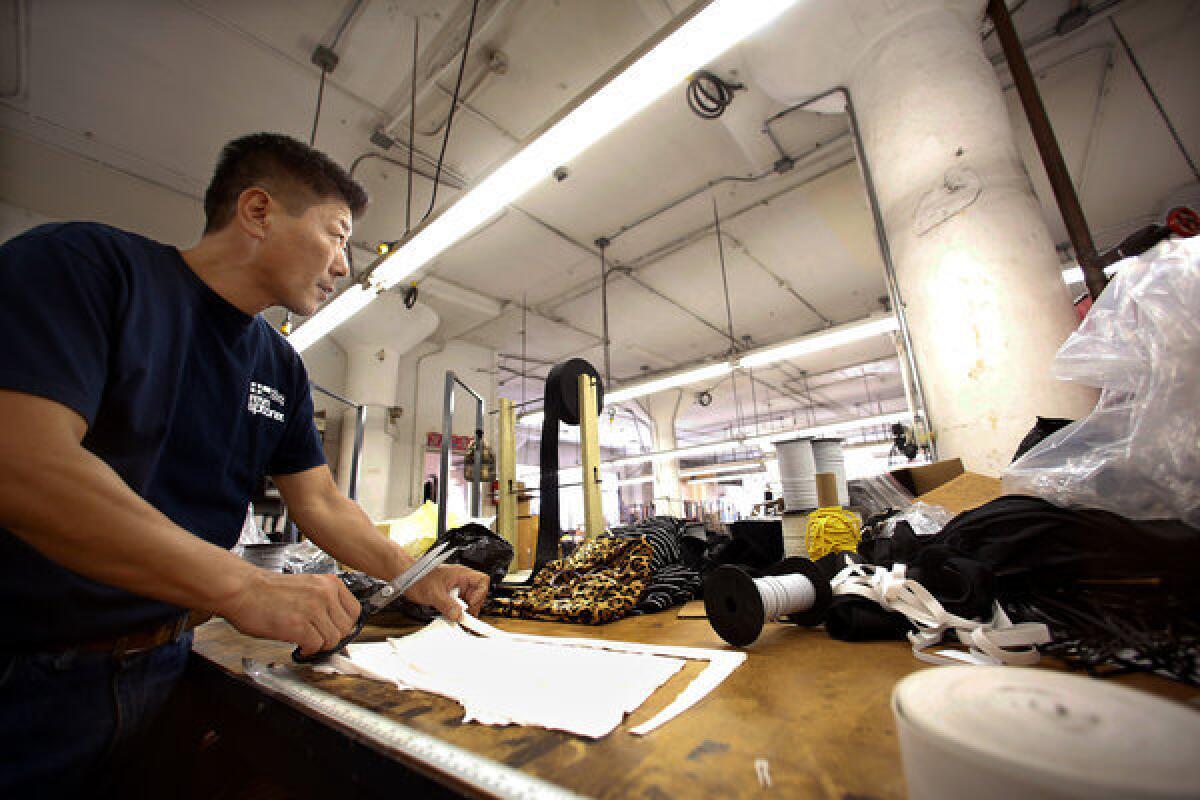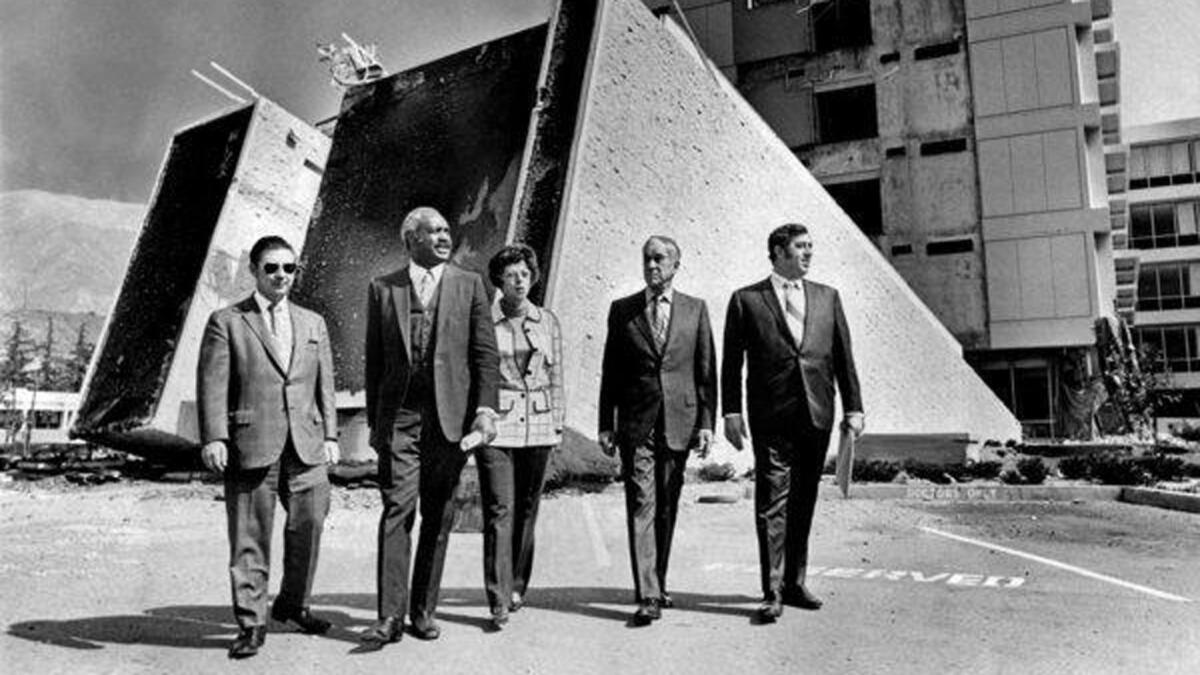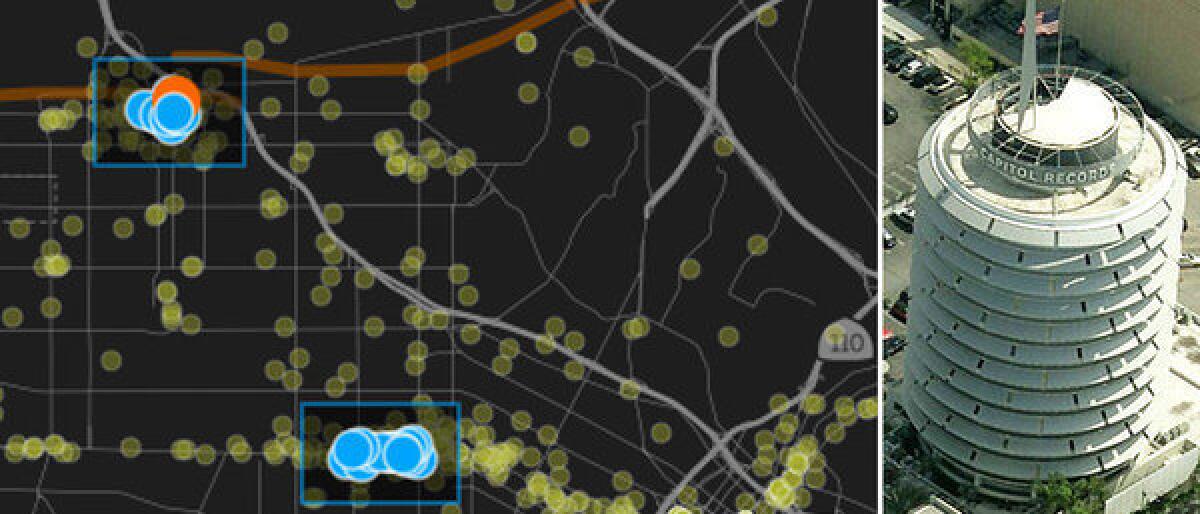Many older L.A. buildings could collapse in an earthquake
The city has rejected calls to make a list of concrete buildings at risk of collapsing in a major quake, but a Times analysis finds there could be more than 1,000 — many of them homes and offices.
- Share via
More than 1,000 old concrete buildings in Los Angeles and hundreds more throughout the county may be at risk of collapsing in a major earthquake, according to a Times analysis.
By the most conservative estimate, as many as 50 of these buildings in the city alone would be destroyed, exposing thousands to injury or death.
A cross-section of the city lives and works in them: seamstresses in downtown factories, white-collar workers in Ventura Boulevard high-rises and condo dwellers on Millionaires' Mile in Westwood.
Despite their sturdy appearance, many older concrete buildings are vulnerable to the sideways movement of a major earthquake because they don't have enough steel reinforcing bars to hold columns in place.
Los Angeles officials have known about the dangers for more than 40 years but have failed to force owners to make their properties safer. The city has even rejected calls to make a list of concrete buildings.
In the absence of city action, university scientists compiled the first comprehensive inventory of potentially dangerous concrete buildings in Los Angeles.
The scientists, however, have declined to make the information public. They said they are willing to share it with L.A. officials, but only if the city requests a copy. The city has not done so, the scientists said.
Recent earthquakes have spotlighted the deadly potential of buildings held up by concrete. A 2011 quake in Christchurch, New Zealand, more than two years ago toppled two concrete office towers, killing 133 people. Many of the 6,000 people killed in a 1995 earthquake in Kobe, Japan, were in concrete buildings.
In 1971, the Sylmar earthquake brought down several concrete structures, killing 52. Twenty-three years later, the Northridge earthquake wrecked more, including a Bullock's department store and Kaiser medical office.
Seismologists said a bigger quake is overdue.
"We know darn well that if a bunch of people die, there will be lots of stories, lots of reports, things will change," said Thomas Heaton, director of Caltech's Earthquake Engineering Research Laboratory. "But the question is, do we have to have lots of people die in order to make this change?"
In the Roaring '20s, concrete buildings helped transform the Los Angeles skyline, as office towers and apartments rose from the city's landscape.
By the 1970s, canyons of concrete towers lined some of L.A.'s most famous streets: Wilshire, Hollywood, Sunset, Ventura, Main and Broadway. They include landmarks such as the Capitol Records tower, the Hollywood Plaza apartments and the W Hotel in Westwood, according to city records.
A team of Times reporters mined thousands of city and county records to identify older concrete buildings. The Times found more than 1,000 buildings in Los Angeles and hundreds elsewhere in the county that appeared to be concrete.
Reporters walked through seven L.A. business districts to gauge the accuracy of the list. They pulled building permits and sent questionnaires to dozens of property owners, asking them to review the details. In these areas, The Times found 68 older concrete buildings, according to public records. Of those, just seven had been retrofitted, or strengthened to survive large earthquakes. The reporters' work covered a fraction of the older concrete structures in the city.
The survey showed the difficulties of accurately identifying concrete buildings. Some city records didn't specify the construction materials used. Some buildings that appeared to be made of concrete turned out to be steel framed, while others that appeared to be brick or steel were concrete.
Hollywood — which is bisected by a fault capable of producing a 7.0 earthquake — has one of the biggest concentrations of concrete buildings. In a few blocks around Hollywood Boulevard and Vine Street, The Times found 14 concrete structures built before 1976, when city codes started requiring more steel rebar. Only three have been retrofitted.
The story is much the same on a stretch of Ventura Boulevard in the Encino area. The Northridge quake battered several concrete buildings in the district, including a 10-story hotel. Owners spent $4 million to better protect it in an earthquake. Out of 10 concrete buildings on that section of the street, only the hotel and one other structure have been strengthened.

David Lee's sewing business occupies part of a building in downtown L.A. To determine whether a building needs retrofitting, owners would have to spend as much as $100,000 on a structural study. (Mel Melcon / Los Angeles Times) More photos
In two downtown neighborhoods, along Broadway and Santee Street, The Times found 17 concrete buildings. None had a record of retrofitting.
One of those buildings is owned by Scott Kim's family. When they bought the five-story factory for their sewing supply business, Kim said, they didn't think to have it examined by a structural engineer.
"It went through other earthquakes, and it's still here," said Kim, whose family paid $5 million for the property a decade ago. "I know back in the day they built buildings much sturdier than buildings today."
Charles Tan, an engineer who has helped retrofit downtown buildings, warned that surviving past earthquakes doesn't mean the structure is safe.
"I've had that said to me quite often: 'Look, this building looks good, has no cracks, no damage,'" Tan said. "A lot of these buildings haven't, at least these specific ones in downtown haven't been tested yet with a high-magnitude earthquake in this exact vicinity."
Owners might be unaware of the risks, but city officials have been warned repeatedly about the dangers of concrete buildings since 1971.
That year, the Sylmar quake shattered two concrete structures at the 46-year-old Veterans Administration Hospital in San Fernando. The three-story buildings pancaked when the concrete crumbled, leaving the red tile roof smashed on the ground. Many patients were crushed under the debris; 49 people died.
Seismic experts were more alarmed by Olive View Medical Center in Sylmar, which had opened just months before and was built using stricter codes. The five-story hospital lurched sideways when some of its first-floor columns broke. Three concrete stairwells toppled. A two-story psychiatric building collapsed. Three people died.
After Sylmar, L.A. officials beefed up seismic codes for new buildings, requiring more steel inside concrete columns to prevent chunks from breaking away. The extra steel acts like a cage, keeping the concrete in place, even if the column cracks.
But structures built before the mid-1970s remained at risk because many lack adequate steel rebar and can't bend. Engineers call these buildings "non-ductile."
When more concrete buildings fell in the 1994 Northridge earthquake, Los Angeles Councilman Hal Bernson and Karl Deppe, a top city building official, decided the time was right to push for tougher retrofitting laws.
Their proposal called for creating a list of all vulnerable buildings across the city, including concrete ones. Property owners would be required to prepare a plan to strengthen them.
"It would be criminal" not to pursue mandatory retrofitting, Deppe said at the time.
Bernson and others had reason to hope. They had successfully pushed the city a decade earlier to require property owners to retrofit or demolish about 8,000 brick buildings. But Los Angeles was still recovering from a recession after the Northridge quake, and then-Mayor Richard Riordan didn't want to burden businesses with more regulations. Bernson's proposal eventually died. Officials instead settled on a voluntary retrofitting program.
"There's two sides: There's the human risk. There's the financial risk," Bernson said in a recent interview. "To me, there was never any question about the two. The question of human life was always more important than financial."
In the early 2000s, retired building officials tried again to make City Hall focus on concrete dangers. Nothing happened.
Greig Smith, Bernson's former chief of staff, tried twice to revive the issue after he was elected to the City Council in 2003. Both attempts failed. He proposed an alternative: Identify concrete buildings and label the hazardous ones. That failed too.
Property owners have been the biggest opponent of retrofitting rules. Even posting warning signs "scared the heck out of" them, Smith said in an interview.
Many owners say they shouldn't have to pay for expensive fixes on their own.
"The cost of doing this would be greater than the value of the building, and that didn't make sense to us," said Carol Schatz, president and chief executive of the Central City Assn.
Researchers who study how concrete buildings fare in earthquakes say 5% of these structures typically collapse. In Los Angeles, that would be at least 50 buildings.
Many more need retrofitting. Nabih Youssef, an engineer who helped strengthen City Hall, the Coliseum and other prominent L.A. structures, said that based on his experience, about 30% of older concrete buildings require major work. Others believe the number is much higher.
To determine whether a building needs retrofitting, owners would have to spend as much as $100,000 on a structural study that ascertains what is inside the columns.
They would have to hire engineers who might install angled steel beams to provide more support, like an exoskeleton. Another solution could be the addition of sturdy interior concrete walls that stretch from the ground to the roof. The fixes could cost $1 million or more. Occupants probably would have to move out during the renovation, at an additional cost.
"Will it be better safety-wise if you reinforce this? Will you help save lives? Yes," said Martha Cox-Nitikman of the Building Owners and Managers Assn. of Greater Los Angeles. "But that's easy to say — if you have money."
In 2006, the university researchers stepped in.
Backed by a $3.6-million grant from the National Science Foundation, a team led by UC Berkeley engineering professor Jack Moehle set out to produce a list of older concrete buildings that might collapse during a major earthquake.
When he and his team embarked on the mission, Moehle declared that "existing vulnerable buildings are the No. 1 seismic safety problem in the world." They hoped their research would "save thousands of lives."
Over the next seven years, Moehle's team identified about 1,500 potentially vulnerable concrete buildings in Los Angeles through public records and their own walking survey. The list was designed to be a first step. Each building would have to be examined more thoroughly to determine whether it needed strengthening.
Moehle declined to give the list to The Times, saying his team could be exposed to legal liability from building owners because the data are far from definitive.

Concrete columns supporting the stairwells of Olive View Medical Center failed because there was too little steel reinforcement. After the 1971 Sylmar earthquake, county officials toured the destruction.
Concrete columns supporting the stairwells of Olive View Medical Center failed because there was too little steel reinforcement. After the 1971 Sylmar earthquake, county officials toured the destruction. (John Malmin / March 4, 1971) More photos
"I don't want to get sued. It's that simple," said Moehle, adding that he would "probably" give it to the city if asked. "It would be their responsibility to figure out what to do with it."
Advocates said the list would give the city a head start in tackling the concrete problem.
"You need to get an elected official who is willing to stick his neck out and take the leadership role," Bernson said.
A spokesman for Mayor Eric Garcetti said he is interested in The Times' report and would review the issue.
Without action from the city, retrofitting has been limited. As downtown and Hollywood gentrified, developers were required to retrofit concrete buildings when converting old office towers and warehouses into residences. Others strengthened their buildings, pressured by lenders or insurers.
Seismologists and engineers say time is running out to fix dangerous concrete buildings.
If the Big One hits the San Andreas fault — and scientists say it's long overdue — seismic waves would cascade into downtown Los Angeles at a magnitude not felt since 1857. Another alarming scenario is a huge temblor striking directly underneath Hollywood or the Westside. More than 300 faults crisscross the L.A. Basin.
Past earthquakes have sparked billions of dollars in retrofitting in the state, with proven results.
Hundreds of state bridges and freeway overpasses have been replaced or retrofitted; all but two are completed. Public and private universities have voluntarily overhauled concrete buildings. State earthquake regulations for hospitals have led to safer, modernized medical buildings.
Los Angeles' 1981 law requiring retrofitting of 8,000 brick buildings saved lives: Although 60 people died in the Northridge quake, none were in brick structures.
But, as structural engineers reported to the state after the Northridge earthquake, the collapse of a single concrete building "has the potential for more loss of life than any other catastrophe in California" since the 1906 San Francisco earthquake.
Don't use Twitter? Email your question.
Earthquake safety has rarely been an issue that draws deep public passions and outrage. Most seismic regulations are approved in the wake of destructive earthquakes, but there hasn't been one in California in nearly 20 years.
"Just like accidents, fires, we don't know when the big earthquake will come," said Yolanda Elizon, a maid for low-income elderly residents at the 10-story Hollywood Plaza Apartments. "I believe if the earthquake comes, only God can save us."
Without a government mandate to fix old concrete buildings, owners are left to make their own judgments about safety.
Ethan Eller manages a 12-story concrete building in the fashion district, where clothing buyers from Paris, Milan and Dubai trickle in each day. He said he doesn't mind spending money to keep his building in good shape and would support reasonable earthquake retrofit requirements.
After the 1985 Mexico City earthquake destroyed many concrete buildings, Eller hired a structural engineer to assess the safety of his. He said he dismissed a costly recommendation to strengthen the lower floors with thick concrete walls and took a less expensive approach. He removed unsafe brick walls, upgraded the building's sprinkler system and bought his tenants emergency kits.
Times staff writer Scott Gold contributed to this report.
Additional credits: Video and graphics, Raoul Rañoa | Web production, Armand Emamdjomeh
FAQ: Concrete buildings, earthquake safety and you
UPDATE: UC releases list of 1,500 buildings, big step for L.A. earthquake safety
DATABASE: Search older concrete buidings
Follow Rong-Gong Lin II (@ronlin), Rosanna Xia (@RosannaXia), and Doug Smith (@latdoug) on Twitter














